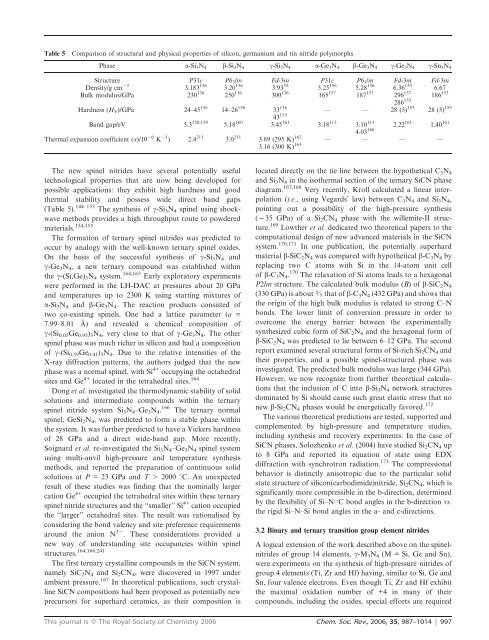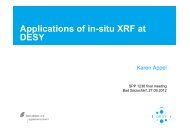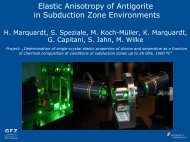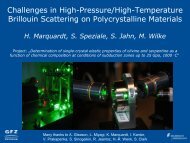High-pressure chemistry of nitride-based materials
High-pressure chemistry of nitride-based materials
High-pressure chemistry of nitride-based materials
You also want an ePaper? Increase the reach of your titles
YUMPU automatically turns print PDFs into web optimized ePapers that Google loves.
Table 5<br />
Comparison <strong>of</strong> structural and physical properties <strong>of</strong> silicon, germanium and tin <strong>nitride</strong> polymorphs<br />
Phase a-Si 3 N 4 b-Si 3 N 4 c-Si 3 N 4 a-Ge 3 N 4 b-Ge 3 N 4 c-Ge 3 N 4 c-Sn 3 N 4<br />
Structure P31c P6 3 /m Fd-3m P31c P6 3 /m Fd-3m Fd-3m<br />
Density/g cm 23 3.183 136 3.20 136 3.93 55 5.25 156 5.28 156 6.36 135 6.67<br />
Bulk modulus/GPa 230 136 250 136 300 136 165 157 187 157 296 157 186 153<br />
286 153<br />
Hardness (H V )/GPa 24–45 136 14–26 136 33 136 — — 28 (5) 153 28 (5) 153<br />
43 153<br />
Band gap/eV 5.3 158,159 5.18 160 3.45 161 3.18 113 3.10 113 2.22 161 1.40 161<br />
4.03 160<br />
Thermal expansion coefficient (a)/10 26 K 21 ) 2.4 211 3.0 211 3.89 (295 K) 162 — — — —<br />
3.16 (300 K) 163<br />
The new spinel <strong>nitride</strong>s have several potentially useful<br />
technological properties that are now being developed for<br />
possible applications: they exhibit high hardness and good<br />
thermal stability and possess wide direct band gaps<br />
(Table 5). 144–153 The synthesis <strong>of</strong> c-Si 3 N 4 spinel using shockwave<br />
methods provides a high throughput route to powdered<br />
<strong>materials</strong>. 154,155<br />
The formation <strong>of</strong> ternary spinel <strong>nitride</strong>s was predicted to<br />
occur by analogy with the well-known ternary spinel oxides.<br />
On the basis <strong>of</strong> the successful synthesis <strong>of</strong> c-Si 3 N 4 and<br />
c-Ge 3 N 4 , a new ternary compound was established within<br />
the c-(Si,Ge) 3 N 4 system. 164,165 Early exploratory experiments<br />
were performed in the LH-DAC at <strong>pressure</strong>s about 20 GPa<br />
and temperatures up to 2300 K using starting mixtures <strong>of</strong><br />
a-Si 3 N 4 and b-Ge 3 N 4 . The reaction products consisted <strong>of</strong><br />
two co-existing spinels. One had a lattice parameter (a =<br />
7.99–8.01 s) and revealed a chemical composition <strong>of</strong><br />
c-(Si 0.05 Ge 0.95 ) 3 N 4 , very close to that <strong>of</strong> c-Ge 3 N 4 . The other<br />
spinel phase was much richer in silicon and had a composition<br />
<strong>of</strong> c-(Si 0.59 Ge 0.41 ) 3 N 4 . Due to the relative intensities <strong>of</strong> the<br />
X-ray diffraction patterns, the authors judged that the new<br />
phase was a normal spinel, with Si 4+ occupying the octahedral<br />
sites and Ge 4+ located in the tetrahedral sites. 164<br />
Dong et al. investigated the thermodynamic stability <strong>of</strong> solid<br />
solutions and intermediate compounds within the ternary<br />
spinel <strong>nitride</strong> system Si 3 N 4 –Ge 3 N 4 . 166 The ternary normal<br />
spinel, GeSi 2 N 4 , was predicted to form a stable phase within<br />
the system. It was further predicted to have a Vickers hardness<br />
<strong>of</strong> 28 GPa and a direct wide-band gap. More recently,<br />
Soignard et al. re-investigated the Si 3 N 4 –Ge 3 N 4 spinel system<br />
using multi-anvil high-<strong>pressure</strong> and temperature synthesis<br />
methods, and reported the preparation <strong>of</strong> continuous solid<br />
solutions at P = 23 GPa and T . 2000 uC. An unexpected<br />
result <strong>of</strong> these studies was finding that the nominally larger<br />
cation Ge 4+ occupied the tetrahedral sites within these ternary<br />
spinel <strong>nitride</strong> structures and the ‘‘smaller’’ Si 4+ cation occupied<br />
the ‘‘larger’’ octahedral sites. The result was rationalised by<br />
considering the bond valency and site preference requirements<br />
around the anion N 32 . These considerations provided a<br />
new way <strong>of</strong> understanding site occupancies within spinel<br />
structures. 164,166,241<br />
The first ternary crystalline compounds in the SiCN system,<br />
namely SiC 2 N 4 and Si 2 CN 4 , were discovered in 1997 under<br />
ambient <strong>pressure</strong>. 167 In theoretical publications, such crystalline<br />
SiCN compositions had been proposed as potentially new<br />
precursors for superhard ceramics, as their composition is<br />
located directly on the tie line between the hypothetical C 3 N 4<br />
and Si 3 N 4 in the isothermal section <strong>of</strong> the ternary SiCN phase<br />
diagram. 167,168 Very recently, Kroll calculated a linear interpolation<br />
(i.e., using Vegards’ law) between C 3 N 4 and Si 3 N 4 ,<br />
pointing out a possibility <strong>of</strong> the high-<strong>pressure</strong> synthesis<br />
(y35 GPa) <strong>of</strong> a Si 2 CN 4 phase with the willemite-II structure.<br />
169 Lowther et al. dedicated two theoretical papers to the<br />
computational design <strong>of</strong> new advanced <strong>materials</strong> in the SiCN<br />
system. 170,171 In one publication, the potentially superhard<br />
material b-SiC 2 N 4 was compared with hypothetical b-C 3 N 4 by<br />
replacing two C atoms with Si in the 14-atom unit cell<br />
<strong>of</strong> b-C 3 N 4 . 170 The relaxation <strong>of</strong> Si atoms leads to a hexagonal<br />
P2/m structure. The calculated bulk modulus (B) <strong>of</strong>b-SiC 2 N 4<br />
(330 GPa) is about O that <strong>of</strong> b-C 3 N 4 (432 GPa) and shows that<br />
the origin <strong>of</strong> the high bulk modulus is related to strong C–N<br />
bonds. The lower limit <strong>of</strong> conversion <strong>pressure</strong> in order to<br />
overcome the energy barrier between the experimentally<br />
synthesized cubic form <strong>of</strong> SiC 2 N 4 and the hexagonal form <strong>of</strong><br />
b-SiC 2 N 4 was predicted to lie between 6–12 GPa. The second<br />
report examined several structural forms <strong>of</strong> Si-rich Si 2 CN 4 and<br />
their properties, and a possible spinel-structured phase was<br />
investigated. The predicted bulk modulus was large (344 GPa).<br />
However, we now recognize from further theoretical calculations<br />
that the inclusion <strong>of</strong> C into b-Si 3 N 4 network structures<br />
dominated by Si should cause such great elastic stress that no<br />
new b-Si 2 CN 4 phases would be energetically favored. 172<br />
The various theoretical predictions are tested, supported and<br />
complemented by high-<strong>pressure</strong> and temperature studies,<br />
including synthesis and recovery experiments. In the case <strong>of</strong><br />
SiCN phases, Solozhenko et al. (2004) have studied Si 2 CN 4 up<br />
to 8 GPa and reported its equation <strong>of</strong> state using EDX<br />
diffraction with synchrotron radiation. 173 The compressional<br />
behavior is distinctly anisotropic due to the particular solid<br />
state structure <strong>of</strong> silicon(carbodimide)<strong>nitride</strong>, Si 2 CN 4 , which is<br />
significantly more compressible in the b-direction, determined<br />
by the flexibility <strong>of</strong> Si–NLC bond angles in the b-direction vs.<br />
the rigid Si–N–Si bond angles in the a- and c-directions.<br />
3.2 Binary and ternary transition group element <strong>nitride</strong>s<br />
A logical extension <strong>of</strong> the work described above on the spinel<strong>nitride</strong>s<br />
<strong>of</strong> group 14 elements, c-M 3 N 4 (M = Si, Ge and Sn),<br />
were experiments on the synthesis <strong>of</strong> high-<strong>pressure</strong> <strong>nitride</strong>s <strong>of</strong><br />
group 4 elements (Ti, Zr and Hf) having, similar to Si, Ge and<br />
Sn, four valence electrons. Even though Ti, Zr and Hf exhibit<br />
the maximal oxidation number <strong>of</strong> +4 in many <strong>of</strong> their<br />
compounds, including the oxides, special efforts are required<br />
This journal is ß The Royal Society <strong>of</strong> Chemistry 2006 Chem. Soc. Rev., 2006, 35, 987–1014 | 997





